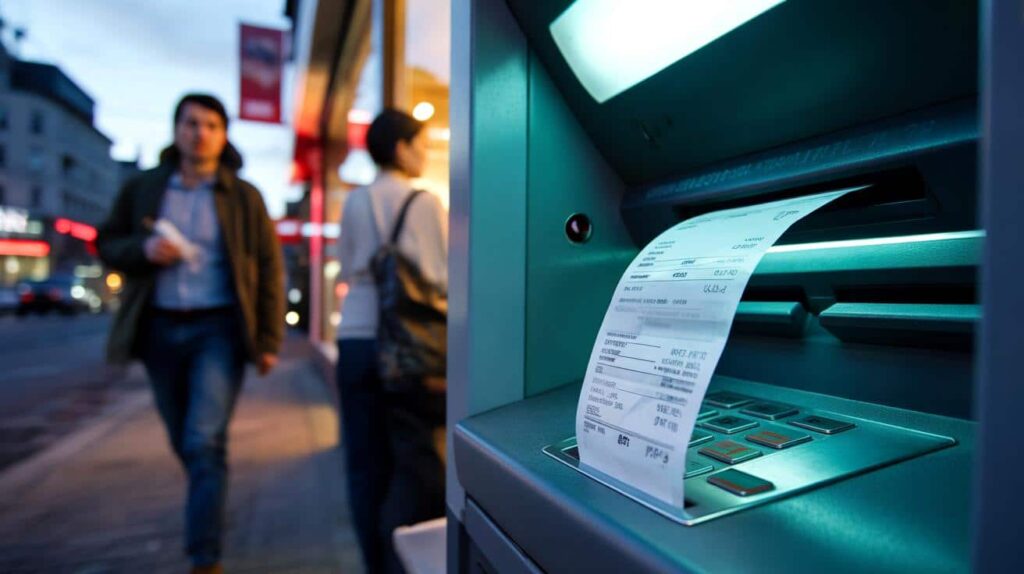Minor habits at the machine can make a significant impact.
Contemporary fraud combines software, interpersonal skills, and bits of data. Even the smallest paper trail at an ATM can quickly ensnare a victim.
The small slip that gives criminals an advantage
The tiny receipt that the machine dispenses may seem innocuous. However, it is not. Even a partial card number, the location code, and the precise time of your withdrawal can pinpoint you as the target. Perpetrators utilize these small hints to construct the larger picture they require.
When you leave a receipt in the tray or toss it in the bin beside the screen, you provide context. Context makes scams credible. It also assists criminals in testing stolen card information or crafting a message that appears legitimate.
What information is on an ATM receipt
- Masked card numbers that still indicate the brand and type of card
- Time, date, and location of the transaction
- ATM ID that connects to a specific machine and banking network
- Available balance or account type in certain regions
- Partial name or branch reference on some models
Never abandon an ATM receipt. Take it. Destroy it. Or opt for no paper at all.
How criminals convert scraps into cash
Fraudsters may call or text you, referencing the exact time and amount of your withdrawal. This detail can be comforting. It lowers your defenses. They then pressure you for “verification” of your PIN or online credentials. This grants access to your account, not theirs.
Others may list receipt information for sale on underground forums. Buyers combine it with leaked emails, compromised passwords, or phone records. This combination facilitates card-not-present transactions, account resets, and attempts at account takeovers.
Simple habits that mitigate the risk
- Always collect the receipt. Do not leave it in the slot or nearby bin.
- Decline paper receipts when the ATM presents a digital option.
- Fold the receipt inward, tear it into small pieces, and separate the fragments.
- At home, shred receipts containing sensitive information or scan and keep nothing physical.
- Cover the keypad with your hand each time you enter your PIN.
- Stand close to the machine and obstruct sightlines with your body.
Your bank will never request your PIN via phone, text, or email. Hang up. Call the number on your card.
Monitor your accounts vigilantly
Real-time alerts can minimize damage. Enable notifications for every withdrawal, purchase, and transfer. Establish a rule for any transaction exceeding a threshold you set. Speed is crucial when a card is compromised.
Most banking applications allow you to lock and unlock your card instantly. Keep that toggle accessible. If you notice a charge you don’t recognize, lock the card first. Then contact your bank. Prompt reporting enhances your chances of a swift refund under your provider’s policies.
Indicators that an ATM may be compromised
- A loose or misaligned card slot, particularly with mismatched colors or materials
- Keypads that feel thick, sponge-like, or are elevated above the surface
- Tape residue, glue, or scratches around the screen and camera area
- A pinhole or unusual plastic piece above the keypad that could conceal a camera
- Unusual error beeps or mechanical noises suggesting a cash trap
If anything appears suspicious, cancel the transaction. Use another machine located inside a staffed branch or a busy area with cameras.
What to do if you made a mistake
Act immediately, not later. Call the number on the back of your card and report potential exposure. Request the bank to closely monitor the account. Ask for a new card if you suspect a skimmer or social-engineering attempt.
Record the time, ATM location, and details of the incident. Take screenshots of any texts or call logs. Dispute any suspicious transactions as soon as you notice them. Many providers offer provisional credits while they investigate.
Paper receipts vs. digital: choose the safer option
Receipts are necessary for audit trails and for customers who prefer physical records. However, digital confirmations reduce the risk of shoulder surfing and dumpster diving. Switch to app confirmations, SMS alerts, or email if your bank provides them.
If you still require paper for budgeting, store it temporarily at home and destroy it after reconciling. Keep photos in a secure notes app instead of a camera roll that syncs broadly.
Best practice at the ATM: no unattended paper, no exposed PIN, and no lingering at the screen.
Establish a 30-second ATM routine
| Step | Action | Why it works |
|---|---|---|
| Approach | Look for tampering and shoulder surfers | Deters skimmers and onlookers |
| PIN entry | Cover keypad with your hand | Blocks cameras and prying eyes |
| Cash out | Secure cash immediately, pocket card | Reduces the risk of snatch-and-grab |
| Receipt | Decline or destroy it | Prevents data-driven scams |
| After | Check app alert, lock card if necessary | Identifies fraud early |
Additional context that saves money and time
Social engineers thrive on urgency. They may claim a “security hold” on your account right after a withdrawal and request a code. That code often authorizes a transfer or login. Slow down the interaction. Call back using the number on your card. A brief delay can prevent a significant loss.
Travel introduces variables. Use machines located inside banks, hotels, or airports where lighting and surveillance are more robust. Withdraw during business hours. Maintain a low daily limit on the card you use for cash. Route the majority of your funds through a separate account that you do not carry.
If you manage finances for family members, teach them the “no-paper, no-PIN talk” rule. A two-minute overview reduces the likelihood that a parent or teenager falls for a fraudulent bank call.
The simplest victory: say “no receipt,” rely on your banking app, and walk away without leaving anything behind.








